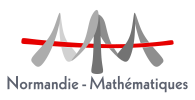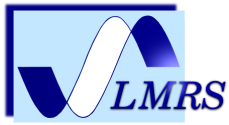Influence of gauges in the TDGL model
We study the convergence orders for a mixed finite element scheme of the Time Dependent Ginzburg Landau model for various gauges. Exemples in 2D and 3D are shown.
We study the convergence orders for a mixed finite element scheme of the Time Dependent Ginzburg Landau model for various gauges. Exemples in 2D and 3D are shown.
Finite Difference formulation of any lattice Boltzmann scheme: consistency and stability
Lattice Boltzmann schemes rely on the enlargement of the size of the target problem in order to solve PDEs in a highly parallelizable and efficient kinetic-like fashion, split into a collision and a stream phase. This structure, despite the well-known advantages from a computational standpoint, is not suitable to construct a rigorous notion of consistency with respect to the target equations and to provide a precise notion of stability.
Sur la méthode de Doeblin-Harris pour les EDP linéaires non-conservatives
Nous verrons comment la théorie de Doeblin-Harris pour l'étude des semi-groupes de Markov peut-être étendue au cadre non-conservatif par une technique de renormalisation d'inspiration probabiliste. Cette méthode permet d'obtenir des résultats quantitatifs de type Krein-Rutman pour des EDP linéaires qui préservent la positivité. Elle permet également de traiter des cas non-ergodiques ainsi que des cas d'environnements périodiques en temps.
The stochastic fast logarithmic equation in $\mathbb{R}^d$ with multiplicative Stratonovich noise
This work (see [1]) is concerned with the existence and uniqueness of the solution for the stochastic fast logarithmic equation with Stratonovich multiplicative noise in $\mathbb{R}^d$. It provides an answer to a critical case (corresponding to the porous media operator $\Delta X^m$ for $m = 0$) left as an open problem in the paper Barbu-Röckner-Russo (see [2]). We face several technical difficulties related both to the degeneracy properties of the logarithm and to the fact that the problem is treated in an unbounded domain.
Une extension probabiliste de la suite d'Oldenburger-Kolakoski
La suite d'Oldenburger-Kolakoski est l'unique suite infinie sur l'alphabet $\{1,2\}$ qui commence par un $1$ et est un point fixe de l'application de codage par plage. Dans cet exposé, nous prendrons un peu de recul par rapport à cette suite bien connue et très étudiée, en introduisant de l'aléa dans le choix des lettres écrites. Cela nous permettra de montrer des résultats portant sur la convergence de la densité de $1$ dans les suites ainsi construites. Dans le cas où les lettres sont choisies selon une suite i.i.d.
A la suite de la présentation (vers 15h00), nous vous proposerons d'échanger sur le portail HAL-Normandie et HAL (Hyper Articles en Ligne)
et/ou toute question sur l'Open access . Il s'agira autour d'un café (accompagné de vos mugs), de vous aider à la création de vos IdHAL et/ou vos CV HAL.
The first question of optimization is whether some function admits a minimum over some space. The family of Ekeland principles adresses the question "what can we say when there is no minimum?" This talk will present the original principle and some variants in an elementary fashion, with hope to highlight the power of this elegant theory.
Poisson Log-Normal model [Aitchison and Ho, 1989] is an incomplete data model for which the maximum likelihood estimator is not available via EM algorithm since the conditional distribution of the latent variable given the observed one is intractable. Efficient variational schemes have been proposed in the past few years. Even though they are computationally fast, they lack theoretical garanties and do not provide any confidence region.
 Le LMRS est l'une des composantes
Le LMRS est l'une des composantes
de la Fédération Normandie-Mathématiques.
© 2025, Laboratoire de Mathématiques Raphaël Salem
